A History of the County of Surrey: Volume 3. Originally published by Victoria County History, London, 1911.
This free content was digitised by double rekeying. All rights reserved.
'Parishes: Buckland', in A History of the County of Surrey: Volume 3, ed. H E Malden (London, 1911), British History Online https://prod.british-history.ac.uk/vch/surrey/vol3/pp173-175 [accessed 23 April 2025].
'Parishes: Buckland', in A History of the County of Surrey: Volume 3. Edited by H E Malden (London, 1911), British History Online, accessed April 23, 2025, https://prod.british-history.ac.uk/vch/surrey/vol3/pp173-175.
"Parishes: Buckland". A History of the County of Surrey: Volume 3. Ed. H E Malden (London, 1911), British History Online. Web. 23 April 2025. https://prod.british-history.ac.uk/vch/surrey/vol3/pp173-175.
In this section
BUCKLAND
Bocland (Testa de Nevill), Bukelonde (xiii cent.); Bokelond (xiv cent.).
Buckland is a small parish and village 2 miles west of Reigate. It is bounded on the north by Waltonon-the-Hill, on the east and south-east by Reigate, on the west and south-west by Betchworth. It contains 1,866 acres of land and 10 of water. It covers the three soils, as usual, the northern boundary being on the summit of the chalk hills, and the parish extending across the sand on to the Wealden Clay. The village and church here, as elsewhere, are situated on the sand. It measures about 1½ miles from east to west, and barely 2 miles from north to south. A small detached portion inclosed by Reigate was added to that parish under the Divided Parishes Act of 1882. Part of the south of Buckland has been added to the ecclesiastical parish of Sidlow Bridge, formed in 1862. The parish is purely rural.
Buckland is traversed by the road from Dorking to Reigate and by the Redhill and Reading branch of the South Eastern Railway. No prehistoric antiquities are recorded.
The rector in 1725 returned to Bishop Willis that there was no chapel, no lecturer, no curate, no Papist, no Nonconformists, no school. The history of the parish seems as uneventful as might be expected, before and since. A succeeding rector, the Rev. Oliph Leigh Spencer (1783–96), was author of a life of Archbishop Chicheley, founder of All Souls College, Oxford, the patrons of the living, and supported his brother by arguments in a rather famous lawsuit when the latter, Mr. Woolley Leigh Spencer, claimed a fellowship at All Souls as being of founder's kin. The claim was successful, 1762. Mr. Oliph Leigh Spencer was himself a fellow. (fn. 1)
There is no record of inclosure.
Buckland Court, the seat of Major F. M. Beaumont, is near the church. Mr. F. H. Beaumont, J.P., lord of the manor, resides at The Cottage. Shagbrook was the seat of the late Sir George Thomas Livesey; Broom Perrow of Mr. J. H. Bovill.
A national school was built in 1822. (fn. 2) It was rebuilt in 1862, and enlarged in 1886. It is subsidized from Johnson's Charity, given in 1857, which produces £11 5s. a year. The National Society are trustees.
MANORS
At the time of the Domesday Survey BUCKLAND, assessed for 2 hides, was held by 'John' of Richard de Tonbridge, lord of Clare. (fn. 3) The manor remained part of the honour of Clare, (fn. 4) and was held of the Earls of Gloucester, (fn. 5) descendants of Richard de Tonbridge.
In the first half of the 13th century Buckland was held as one knight's fee by Alicia de Dammartin. (fn. 6) She was the daughter of Odo de Dammartin and Margery his wife; before 1231 she was married to John de Wauton, (fn. 7) who thus became possessed of Buckland. In 1293 the manor and church of Buckland were conveyed to Guy Ferre, junior, by John Wauton, (fn. 8) a settlement being made in 1302 on Guy and his heirs, with remainder in default of issue to Sir John Claron and his issue, afterwards to the right heirs of Guy. (fn. 9) Guy Ferre (fn. 10) was in the suite of Eleanor Countess of Bar, daughter of Edward I, whom he constantly accompanied abroad; (fn. 11) after her death he probably continued in the service of her daughter Joan. (fn. 12) He died childless in 1322–3, and his lands at Buckland therefore passed to Claron. (fn. 13) Eleanor widow of Guy Ferre retained a third of the manor as dower, (fn. 14) as she presented to the church which belonged to the manor after 1346. (fn. 15) Sir John Claron died in or before the year 1342, (fn. 16) but it is not apparent who his heirs were. The next record of the manor shows that two-thirds of it were held by John de Warenne, Earl of Surrey, at his death in 1347, and that he held in the right of his wife Joan, daughter of Eleanor Countess of Bar. (fn. 17)
John de Warenne, Earl of Surrey, died without male issue, his next heir being Richard, Earl of Arundel, son of his sister Alice and Edmund, late Earl of Arundel. Richard accordingly inherited the manor, (fn. 18) a settlement being made in 1349 on his younger son, Sir John de Arundel, in tail male. (fn. 19) Sir John perished at sea in 1379, and was succeeded by his son John, (fn. 20) who received during his minority an annual grant of 40 marks for his maintenance from Richard Earl of Arundel, 'being the amount of his farm for the manor of Bokeland, Surrey, in the king's hands by reason of the said minority.' (fn. 21) Eleanor widow of the first Sir John married Reginald Lord Cobham as her second husband, (fn. 22) and he at his death in 1402–3 was seised of a third of the manor of Buckland in the right of his wife. (fn. 23) The major part of the manor continued to be held by the second Sir John de Arundel, and at his death passed to his son John, who became twelfth Earl of Arundel. (fn. 24) The latter died in 1421. (fn. 25) His widow Eleanor married Sir Richard Poynings, who was assessed for the manor in 1428; (fn. 26) after his death she married Sir Walter Hungerford, and died in 1455, when William, her second son by the twelfth earl, inherited the manor. (fn. 27) He had become fifteenth Earl of Arundel in 1438, (fn. 28) and the manor appears to have remained in the hands of succeeding earls until 1564. Henry Earl of Arundel settled the manor on his daughter Jane, who had married John Lord Lumley. (fn. 29) In 1567 Lord Lumley and Jane conveyed the property to Herbert Pelham and Roger Dallender. (fn. 30) Pelham quitclaimed his right to Dallender in 1569, (fn. 31) and the latter held until his death in 1599, (fn. 32) when his son William inherited his lands, a settlement having been made in 1589 on the marriage of William with Margaret Leigh. (fn. 33) William died in 1618, and his son Ralph succeeded him. (fn. 34) Ralph Dallender in 1654 joined with several other members of the family in a sale to George Browne, (fn. 35) who married a daughter of Sir Ambrose Browne of Betchworth. Ambrose and John Browne, sons of George, held the manor successively. (fn. 36) On the death without issue of John Browne in 1736 his estates passed to the family of his sister Philippa, who had married William Jordan of Gatwick; their son Thomas Jordan died unmarried in 1750, when his sisters Elizabeth wife of William Beaumont and Philippa wife of John Sharp became his heirs. (fn. 37) The manor of Buckland became the property of the former, Philippa and John Sharpe having released their claim to her in 1753. (fn. 38) From that time until the present the manor has been held by descendants of William and Elizabeth Beaumont, remaining usually in the younger branch of the family. (fn. 39) Mr. F. H. Beaumont is at present lord of the manor.
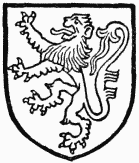
Fitz Alan, Earl of Arundel. Gules a lion or.
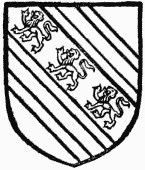
Browne. Sable three lions passant bendwise between two double cotises argent.
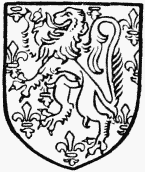
Beaumont. Azure powdered with fleurs de lis argent and a lion argent.
A mill in Buckland is recorded in the Domesday Survey, when its value was stated to be 6s. (fn. 40) It was probably identical with the mill in Hartswood, parcel of the manor of Buckland, of which later record is found (vide infra). In 1268 John de Wauton and his heirs received a grant of free warren in his demesne lands in Buckland and elsewhere. (fn. 41) Guy Ferre received a grant of free warren in his demesne lands of Buckland in 1291, (fn. 42) nearly two years before the formal grant of the manor was made him by John de Wauton. In 1350 a complaint was made by the Earl of Arundel that his free chases and warrens at Buckland had been entered by trespassers who hunted and took away the deer, hares, rabbits, pheasants, and partridges. (fn. 43) In 1390 it was found that the manor was charged with a payment of 2d. yearly, then due to Richard Chamberlayn, who was custodian of the warren there. (fn. 44)
HARTSWOOD
HARTSWOOD lying in the ecclesiastical parish of Sidlow Bridge, originally formed part of the manor of Buckland. The name occurs early in the 13th century, when John de Wauton, lord of the manor of Buckland, granted to Robert de Hartswood, for his homage and service, a field called Rudene lying between the mill of 'Herteswode' and a field called Pegesull. (fn. 45) There is no further mention of this mill, which apparently fell into disuse. In 1379 John de Arundel, lord of Buckland, received licence to inclose his wood of 'Herteswode,' and to impark 360 acres of land adjacent thereto. (fn. 46) An extent of the manor of Buckland made in 1380 includes 100 acres of land there among the appurtenances. (fn. 47) Hartswood remained part of the manor until 1569, when it seems to have been conveyed by Roger Dallender, as lands in the parish of Buckland, including 300 acres of wood, to John Skinner (fn. 48); the latter died in 1583–4 seised of the manor, park, and demesnes of Hartswood in Buckland. (fn. 49) In 1589 William Poyntz, brother-in-law and heir of Skinner, was lord of the manor; (fn. 50) it afterwards passed to Richard Elyot of Albury, nephew, and in default of male heirs to Poyntz's son John, heir of the same John Skinner, (fn. 51) being the son of his sister Elizabeth. Richard died in 1608. (fn. 52) The manor was afterwards held by his brother or uncle Thomas Elyot, (fn. 53) and in 1620 was, with the park, conveyed by him and other members of this family to Sir William Garway. (fn. 54) In 1632 it was held by Lionel Wright, who sold it in that year to John Hatt and Elizabeth his wife, receiving in the following year a ninety-nine-years' lease of the capital messuage and mansion house belonging to the manor. (fn. 55) By 1653 it was in the possession of the family of Moore. (fn. 56) Susan daughter and heir of Thomas Moore, who died about 1676, married Robert Bristow. (fn. 57) After her husband's death, she and trustees conveyed the manor in 1718 to Sir William Scawen, (fn. 58) in whose family it remained until 1781, when James Seawen sold it to Sir Merrick Burrell. (fn. 59) Sir Peter Burrell, great-nephew of Sir Merrick, inherited the latter's estates in 1787, (fn. 60) and sold the manor shortly afterwards to William Clutton. (fn. 61) The property is still in this family. Mr. Ralph William Clutton is present owner.
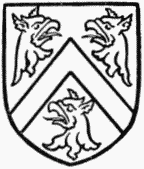
Scawen. Argent a cheveron gules between three griffons' heads razed sable, those in chief facing each other.
CHURCH
The church of OUR LADY consists of a chancel 22 ft. 2 in. by 19 ft. 6 in., small north transeptor vestry 11 ft. by 9 ft., nave 44 ft. 6 in. by 21 ft. 8 in., and a south porch.
The church was rebuilt in 1860, and has no architectural details earlier than this date, and all the fittings are modern. The walls are built of ironstone rubble, and the window tracery is of 14th-century style. The bells are hung in a shingled wood turret with a spire, rising above the roof at the west end of the nave, and supported on wooden posts from the floor.
In two of the windows is some old stained glass. The south-west window of the nave has a figure of St. Peter holding the two keys; the head and keys, although old, have the appearance of being later than the rest of the figure; the canopy work (with the name below) is generally modern, but has some old foliage in red and blue set in it; the head of the canopy is apparently old. The other window at the north-east of the nave has the figure of St. Paul; on this again the head and sword are less worn than the rest of the figure. There are six bells, all by Warner; the three largest were recast in 1900 from three by William Eldridge dated 1681; the third is dated 1900, the second 1860, and the treble 1892.
The plate was stolen in 1850, but a set was given to replace it by the then rector, Dr. Hulse, consisting of a cup and cover, a paten, a flagon, and two plates. There are also two silver candlesticks of 1691, a paten of 1894, two cruets of 1893, and a flagon of 1907. There is a note in the register mentioning the complete restoration of the church and rebuilding of the chancel in 1859–60, at a cost of £2,253.
The registers date from 1560, but are an 18th-century transcript. The first volume contains two books of unequal size in parchment bound together; the first part has baptisms, marriages, and burials to 1667 with one baptism of 1675, and the second baptisms and burials to 1776 and marriages to 1753. The second book contains marriages from 1754 to 1812, and the third baptisms and burials from 1777 to 1812.
ADVOWSON
The Domesday Survey records the existence of a church at Buckland. (fn. 62) From its foundation it belonged to the manor of Buckland, and was held with it as 'the church of the manor,' until 1567, (fn. 63) the patronage being in the hands of the lord of the manor. (fn. 64) When Lord Lumley conveyed the manor to Pelham and Dallender in 1567, however, he retained the advowson of the church, and was possessed of it at his death in 1609. (fn. 65) His heir was Henry Lloyd, son of his sister Barbara. (fn. 66) In 1628 Henry Lloyd alias Fludd held the advowson. (fn. 67) Lloyd sold it to All Souls College, Oxford, for £335, on 18 February 1639. (fn. 68) But in 1658 the Parliamentary Commissioners found that George Browne, lord of the manor, held the advowson. (fn. 69) Probably the royalist college had been deprived during the Civil War. In 1661 Lloyd had resumed possession, presumably as a step in the restoration of the advowson to the college, which held it in 1674, (fn. 70) and still holds.
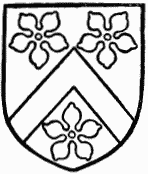
All Souls College, Oxford. Argent a cheveron between three cinquefoils gules.
CHARITIES
In 1704 Laurence Denton left 30s. a year rent from a meadow since called Poor's Land, for relief of poor not receiving parish relief. It is now worth £6 6s. a year. In 1733 Mr. John Brown, lord of the manor, left three acres for a similar purpose. This is now represented by a sum in consols. A Mr. William Cooke left £65 4s. 4d. consols.
The above are all consolidated with Smith's charity, and applied for general purposes of medical relief, nursing, provident clubs, or temporary loans.
Smith's charity is distributed as in other Surrey parishes.